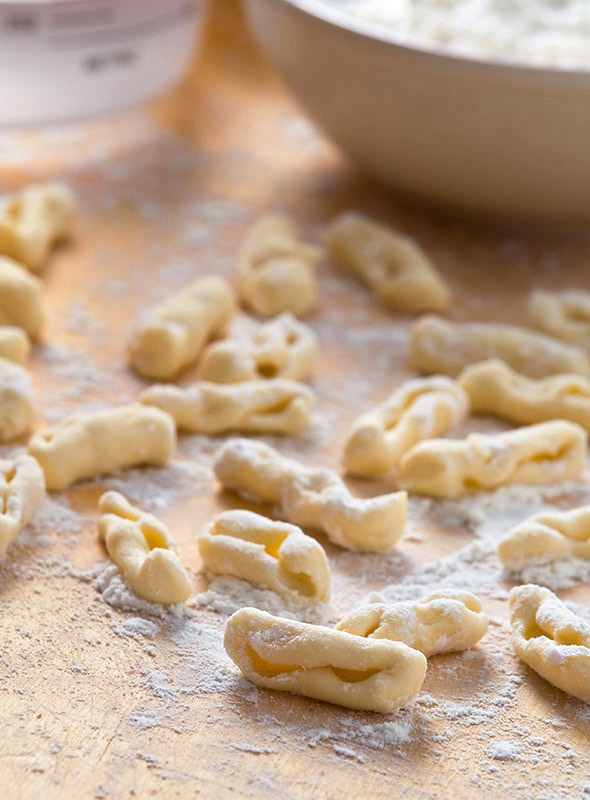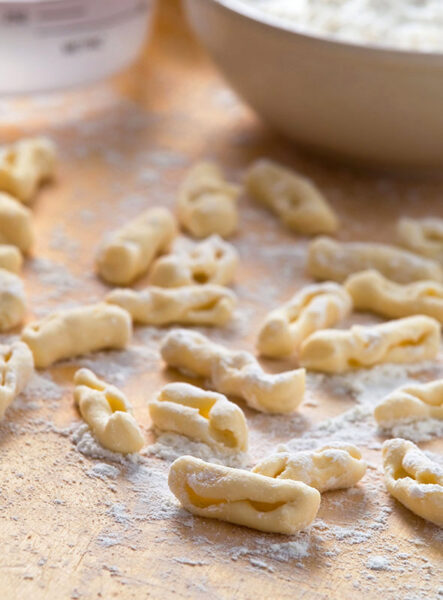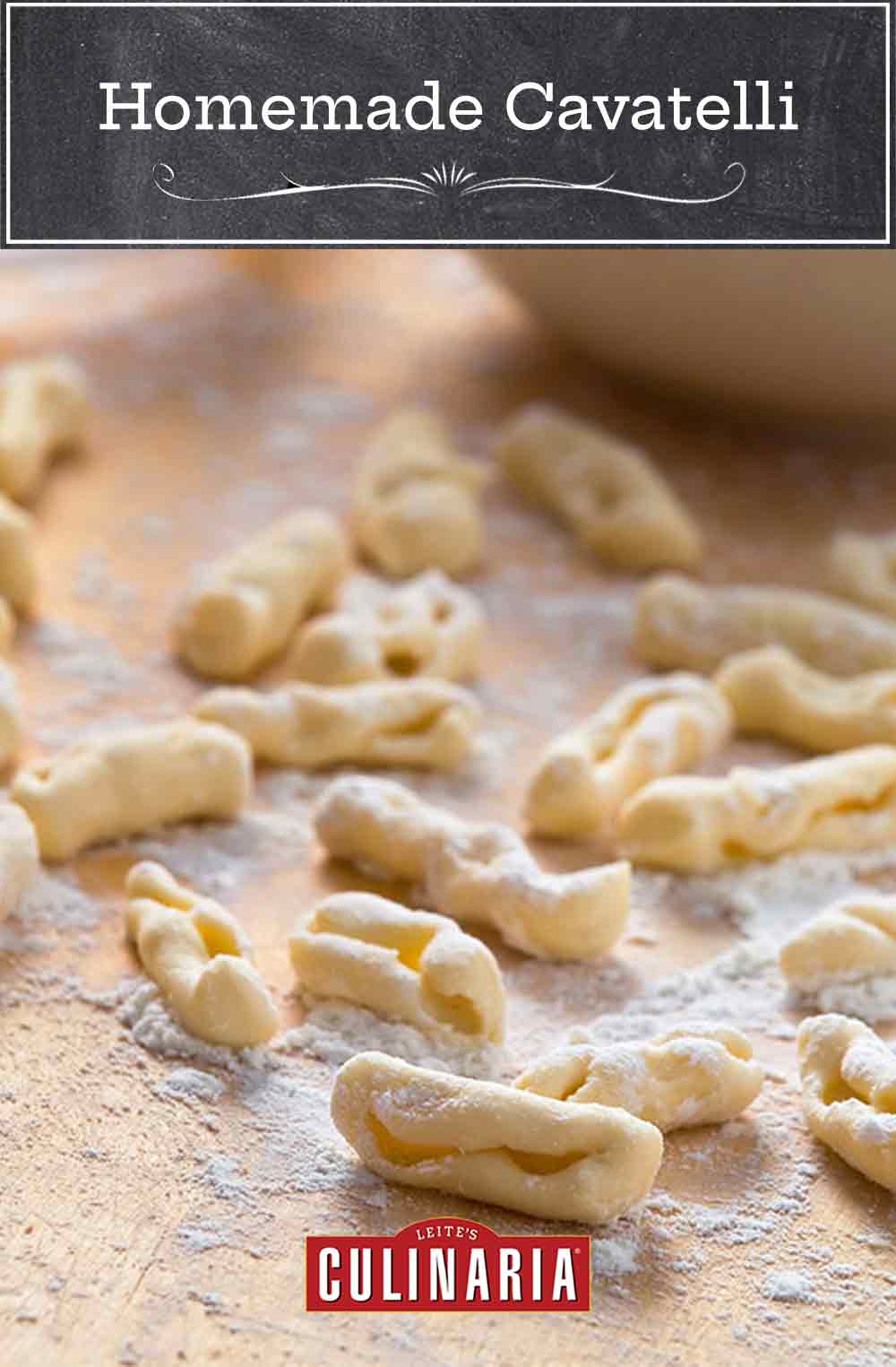
Want to Save This?
These homemade cavatelli are little curls of pasta and are quite common in southern Italy, where they’re commonly served simply, as in cavatelli with turkey sausage. Yes, you can make your own homemade cavatelli pasta and no, you don’t need a pasta maker. What you will need, however, is a little patience with yourself as you learn to fashion a cavatelli. We’ve included a few different ways to go about it along with links to some helpful how-to photos, so rest assured, you can do this. And after one taste, you’ll want to do this week after week after week.–The Silver Spoon Kitchen

Homemade Cavatelli
Equipment
- Pastry scraper (optional)
Ingredients
- 2 1/4 pounds (8 cups) “00” flour
- Sea salt
- 2 tablespoons extra-virgin olive oil
- 2 to 2 1/2 cups cold water, or as needed
Instructions
- Place the flour in a mound on a work counter or in a large bowl and make a well in the center. Add a pinch of salt, the oil, and 2 cups cold water and mix with a fork, pastry blender, or your fingertips until the mixture forms a firm dough. If necessary, add more water, a few tablespoons at a time, until the dough comes together.
- Pinch off a small portion of dough and, using your hands, roll it against your work surface into a long rope no more than 1/2 inch (1 centimeter) thick.You want to roll with your hands beginning at the center and working toward the edges to try to keep the rope an even thickness. (If the dough is sticky or difficult to work with, stop rolling. Cover the dough and set it aside at room temperature for 30 to 60 minutes. Then proceed with the rolling.)
- Using a pastry scraper or a butter knife, slice the rope crosswise into 1/2- to 3/4-inch (2- to 3-centimeter) portions.
- To shape the cavatelli with your thumb, use your thumb to push the dough against the work surface and away from you so that the dough gently curls around itself.To shape the cavatelli with your fingertips, take the first 2 fingers on your dominant hand and push the dough against the work surface as you draw it toward you so that the dough gently curls around itself.To shape the cavatelli with a butter knife, roll each length into a little rope. If the dough is still sticky, lightly flour it. Place the back edge of a butter knife right alongside a rope and turn the knife at a 45-degree angle to your work surface. Push the knife and the pasta down and away from you so that the pasta gently curls a little around it.
- Spread the cavatelli in a single layer on lightly floured baking sheets or parchment paper, being careful that the cavatelli do not touch. Let dry slightly at room temperature for 30 to 45 minutes. (To freeze the cavatelli, slide the sheets into the freezer until the pasta is firm. Toss cavatelli into resealable plastic bags and freeze for up to 3 months.)
- To cook the cavatelli, bring a pot of salted water to a boil.
- Toss in the cavatelli and cook until they float to the surface of the water and remain there, 3 to 8 minutes, depending on the size. (If cooked straight from the freezer, the cavatelli will need an extra 1 to 2 minutes.)
- Using a slotted spoon, transfer the pasta to a colander to drain before saucing and slurping.
Nutrition
Nutrition information is automatically calculated, so should only be used as an approximation.
Recipe Testers’ Reviews
I’d never made pasta before, so I was eager to give this homemade cavatelli recipe a shot. The results were delicious. (Note: I had to cut the recipe in half because I realized when I started that I only had a 2-pound bag pasta flour and the recipe calls for 2 1/4 pounds.) My hands-on time was longer than estimated because as a beginner, I had some trouble shaping the cavatelli at first, and my lack of the correct tools slowed me down a bit. I used a total of 1 1/4 cups water, about 1/4 cup at a time. I used my fingers to mix the dough, which was a little messy but seemed to work just fine. I’d describe the process as: Take a small handful of the dough and roll into a rope about 1/2″ thick. Using a pastry cutter, cut 3/4″ length from the rope and, using gentle pressure, pull the cutter toward you at a 45 degree angle causing the dough to roll up behind the cutter forming a little canoe shape. I placed the shaped cavatelli on a lightly floured pan so that they wouldn’t stick. At no point during the cutting and shaping did I find the dough too sticky or need to flour the work surface. This worked pretty well, but my progress was slow, as I found using the flat side of a knife difficult. I tried a metal spatula, and things went much more quickly from that point on. I will definitely be buying a pastry scraper, so that I can make this recipe again with greater ease. Once shaped, my cavatelli were 2 inches long, and I cooked them for 8 minutes.
I can’t resist homemade pasta. Also, my spouse is gluten-intolerant, so I make pasta special for her. (On the LC site there is a gluten free flour mix that works well for pasta. This is what I used.) It took almost 2 1/2 cups water to get the dough right so it was not sticky. Being a little old school, I used my God-given mixers—my fingers. I always find it easier to use a really big bowl in case the dam of flour breaks. As far as forming the cavatelli, it is a little time-consuming. After rolling the lengths, a small portion gave me about 10 inches, which I cut to about 1/2- to 3/4-inch pieces. It’s going to take some time to experiment with the best way to roll them out. I found it much easier to roll them between the palms of my hands and line them up to curl. Just be sure to dip the back of the knife in a small bowl of flour or some olive oil. It took a little over an hour to make enough for three, and I still had a good amount of dough leftover for another use (pizza, oh yeah). Just place on a baking sheet and sprinkle with a little flour to keep from sticking together till finished. I cooked the pasta in a large pot of salted boiling water for about 10 minutes. Broccoli was done in a large frying pan and blanched for 5 minutes. I sautéed 2 minced garlic cloves with 1/2 cup olive oil for the sauce, tossed in the pasta and broccoli, and topped with grated cheese. It was delicious—I’ll definitely make this homemade cavatelli again.
I had a great time making hand-shaped pasta for the first time using this homemade cavatelli recipe. I’ve used a pasta roller and cutter before to make noodles, but never thought I could form my own shapes—I’d assumed that only Italian grannies could do it, and lacking one, I’d never had anyone to teach me. I read and reread the easy-sounding recipe, then watched some online videos and GIFs to visualize the process before I felt ready to try it myself. I used flour labeled “pasta flour” because my grocery didn’t have any “00.” I gradually added about 2 cups water until I got a firm Play-Doh-like texture. I used a large bowl instead of the counter. I dumped the water in the center, about 1/2 cup at a time at first, and started mixing with a fork, then as the dough came together, with my fingers. I let the dough rest and hydrate for about an hour before beginning to shape it, something I’d seen suggested in other recipes. I think this helped, as it was not at all sticky. I used a large wood cutting board as my work surface and hardly needed any flour to dust the ropes/cut lengths or shaped pasta. I used 3/4″ lengths, and as long as the dough ropes were evenly 1/2″ thick, had no trouble with the size. The butter knife technique worked well, and my shapes got better and better as I went. I also tried using my fingertips instead of the knife and found that worked too.The dough “rested” wrapped in plastic wrap for 1 hour before I started to make ropes, cut the pasta, and shape it. There’s no trick—I swear, it’s easy! I liked to do about a walnut-sized portion at a time, making ropes, cutting, then shaping that batch right away. The dough isn’t sticky and dries out quickly, so I kept it wrapped as I worked with each portion. It took awhile to shape all the dough, but when I finished, I had enough cavatelli to eat that night and lots to freeze. The cavatelli took about 7 minutes to boil before they started floating and were al dente. Depending on how thin or thick they’re rolled, I’ll bet the timing varies widely. I’d start testing for doneness at 5 minutes and recommend cooking them for up to 10 minutes, tasting one every minute or so, because everyone is going to shape these a little differently. I’m no Italian granny, but I couldn’t be prouder of myself for filling my freezer with these delicious, homey, handmade cavatelli, and I can’t wait to try them with some of my favorite sauces. The specific flour brand I used was Hodgson Mill Golden Semolina & Extra Fancy Durum Pasta Flour (2 lbs/908g package). This seemed to work just fine with the other recipe amounts. I wish I’d added more salt, though, as 2 generous pinches wasn’t quite enough…but then,, I think I generally don’t salt my pasta water enough.
Well, this homemade cavatelli recipe is not for the uninitiated. I’ve been fantasizing about making homemade cavatelli for a while but hadn’t had the nerve until now. The thing is, there is a knack to it, and it took me a while to get there. I bought a 1-kilogram bag of 00 flour (Antimo Caputo brand) at Whole Foods. I ended up using about 2 cups water for my dough. I understand that factors including humidity and the specific flour affect the dough, and I was afraid of adding too much water at the start. I used my hands to mix and produced a stiff dough that really needed to rest for about 30 minutes before it was workable. I ended up cutting the dough in about 8 pieces and rolling each piece into a rope. My first batch was difficult to work with and came out too thick. After resting, the dough was much easier to work with and almost fleshy in texture. The ropes of dough should be no more than 1/2 inch in diameter, probably less. I cut them into 1/4-inch pieces. To form the cavatelli, I found that a bench scraper worked beautifully. You hold the bench scraper over the far end of the disk, and scrape or drag the dough against the board so that it curls over the blade, forming what I’ve read described as a “canoe.” I found pictures to be helpful. The recipe makes quite a lot of cavatelli, and I dried some and froze some to see how it would work. Anyway, it took me well over 90 minutes to finish my cavatelli, putting it out of the realm of a weeknight meal. I suppose I might get faster at it with practice. The pasta only took 3 to 4 minutes to cook. You know it’s done when the boiling cavatelli float to the top. The result was quite delicious.











Enjoyed reading your recipe and the comments. I grew up helping my mom make cavatelli but only started making them myself in recent years. We always rolled the pieces on a fork held upright in one hand and pressing and rolling downward wirh the index and/or middle finger of the other hand forming the “cave”. It goes pretty quick once you get the hang of it. My 7 yr old grandson loves these and can roll them almost as fast as me. You can also just do them with your fingers on a breadboard. We like the tine indentations though. Thank you for posting!
Hi Connie, what a lovely legacy that you are passing on to your grandson. Thank you for sharing!
I discovered my never-used gnocchi board on the same day that I came across this recipe. The dough was simple to make and easy to handle. I made them this afternoon and by dinner, they were dry and ready to go. Forming the cavatelli took a little getting used to but by the midpoint, I had built up a good rhythm and got through the second half much faster than the first.
I served them with tomato sugo and pecorino cheese. We ate about 1/3 and I froze the rest, the way you suggested. I’m so happy I found both this recipe and my gnocchi board. Kudos on your perfect timing!
Those boards are so much fun, aren’t they Jenny?
This brings back memories of countless Sunday’s sitting in my grandparent’s kitchen, rolling these out. Once they were in the pasta pot, bubbling away, we’d head out to the garden to pick fresh sweet basil for the sauce that was simmering on the stovetop and hot peppers that were diced tableside and served with the pasta.
tc, sounds wonderful!